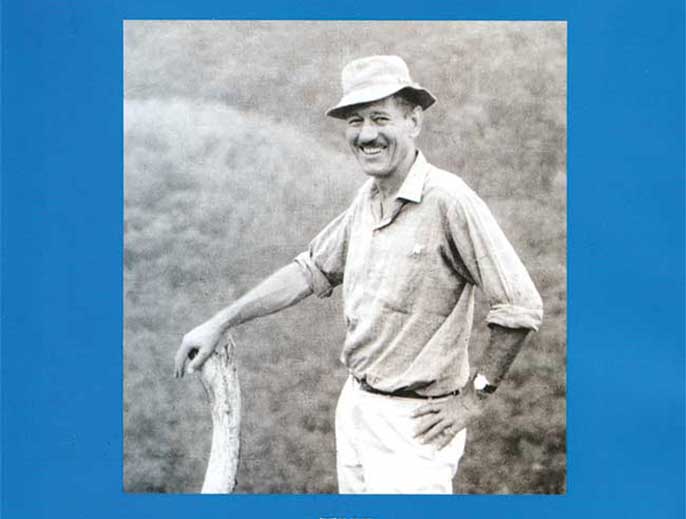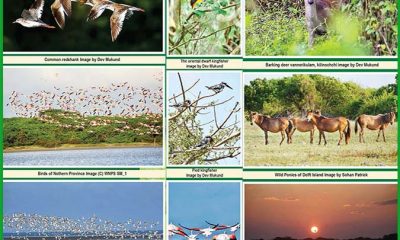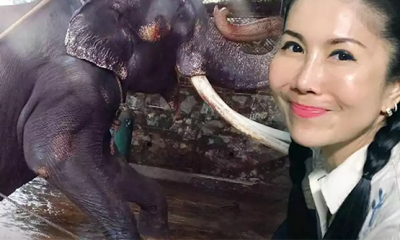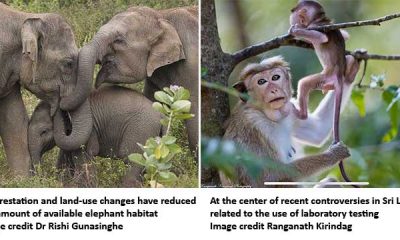Features
To a Sri Lankan at heart

Thilo W. Hoffmann biography
S. A. I. Elapatha
Forty years ago, a young man with a Master’s Degree in Agriculture in his pocket, set out for Sri Lanka to be employed in a well established and reputable foreign Company of the same nationality as his. Born in 1922, the son of a well known paediatrician of his day, he was never in want and need never have left his homeland, but the spirit of adventure that compelled some people to leave their country and go to another urged him on.
Little did he know then that he would carve out for himself a niche in the progress of this country – namely in the field of wildlife and nature conservation. Sri Lanka would also become his second home. Of all the Europeans I have met, he is one of the very very few who has a deep and abiding love for the country he worked in.
This young man in the course of time became a Director, then Managing Director, and is now Chairman of the Company he joined as a Junior Executive. Traveling around the country as an Agricultural Adviser for his Company, he used his free time to explore the jungles and remote areas. He soon developed a deep appreciation of nature. His charming wife willingly accompanied him on many of these trips and encouraged him throughout the long period of active involvement in nature conservation.
He soon started to take an active interest by joining the Wildlife Protection Society, as it was then called. He first came in to the Committee as Treasurer in 1961, then as Secretary in 1962, and finally as President from 1968 – 1980. If ever he took on a job it was with a total sense of dedication; besides he was blessed with a keen and perceptive mind. That was the secret of his success.
So, for a span of 25 years he has devoted his energies, apart from doing his own work, to the conservation of nature and wildlife in this country. He was elected an Honorary Life Member of the Society in recognition of his services. It was he who was responsible for widening the scope of the Society by enlarging it from Wildlife Protection only into the broader sphere of Conservation of Nature as well.
He was again responsible for changing the objects of the Society and thereby banned shooting as a sport in Sri Lanka. Throughout this period he has contributed numerous articles and papers on conservation and natural history mainly to the ‘Loris’ magazine, and acted as Editor for revised editions of Phillips’ ‘Checklist of the Birds of Sri Lanka’ and the important `Manual of the Mammals’, both published by the Society.
His monograph on the Sinharaja forest in 1972 came at a most opportune moment. Sinharaja, the only remaining tropical rain forest of some size in Sri Lanka, was to be exploited by the State. He was mainly responsible for spearheading opposition through the Society, of which he was the President. It was then that he came to my home and said: “Sam, let’s go and see the Sinharaja in its pristine glory before the people ravage and exploit it. I would like your children also to see it, because it is their heritage. Maybe one of them will remember it as it was and what has happened to it, and we may still make a conservationist out of him”.
He was already thinking of the future. During his tenure as Secretary of the Society and as President, membership increased by leaps and bounds and reached a total of 5,000 members. When he started as Secretary the membership of the Society was in the region of about 500. It had no office or headquarters; the half yearly or annual meetings of the Society were usually held in some Planters’ Club Upcountry. It had no funds – just a few back copies of the ‘Loris’ magazine. It was he who found the present building and negotiated to lease it out for the Society. I remember that he spent many weekends bringing the cement bricks by hand and setting up the extension of the small origins building and the wall that now surrounds thee Society headquarters.
It was he who encourages the members of the Committee and also others in the drive for membership of the Society. Today the Society is a powerful force in the country’s march towards conservation. If there was any one person who spearheaded the Society to be a live force in this direction, it was this man.
Even though he shunned jaunts abroad and International Conferences, he nevertheless attended some if he thought them useful in any]way to this country, such as the Asian Section of the International Council for Bird Preservation Conferences in Indonesia in 1976 and Thailand in 1980; four years later he brought the Conference to Sri Lanka. In these trips he never asked for or got money for travel or subsistence. It was entirely out of his own pocket.
Even in Sri Lanka, wherever he went in the promotion of conservation or protection of wildlife, he spent his own money. His company, in appreciation of his work, helped him by providing their secretarial services. I know that he devoted at least four hours a day towards the Society and the broader matters off conservation.
Besides he was responsible fix many permanent changes in the status of conservation areas, e.g. the incorporation of Intermediate Zones in National Parks, extensions of Parks, notably the Wilpattu West Sanctuary, and the creation of new conservation areas. Years, even decades, earlier he advocated many ideas now in current use (greatest possible contiguous extents of conservation areas for genetic diversity, capture for domestication of surplus elephants, management of parks, the creation of Buffer Zones, etc).
He was the first to propose Marine Sanctuaries and Coastal Reserves in Sri Lanka. He made a determined fight for more than a decade against the destruction of coral reefs (for lime burning). He pioneered the conservation of wetlands_ He was made a member of the Coast Conservation Advisory Council in recognition of his work. He was the first recipient of the Conservation Award instituted by the late Mr. Selwyn Samaraweera. In recent years he has also devoted much of his time and energy to the protection of birds both nationally and internationally; he is the Chairman/Secretary and Editor of the Ceylon Bird Club.
All these activities always entailed voluminous correspondence in Sri Lanka and abroad.Since the beginning of 1986 he also functions as Project Manager for the Mahaweli Enivronment Project, in an entirely honorary capacity. This project which is funded chiefly by USAID includes the establishment of four new national parks totaling nearly 600 sq. miles in the Lower Mahaweli region,
i.e. Maduru Oya, Wasgomuwa, Flood Plains and Somawathiya, as well as the two adjoining nature reserves of Minneriya-Giritale and Tirikonamadu. A new park at Randenigala is also planned.It was felt that an outsider with the necessary qualifications, especially a deep understanding of out wildlife and its conservation, could assist the Department of Wildlife Conservation more effectively in the implementation of this major project, which for various reasons had fallen well behind schedule.
In the field of tourism he served on the Policy Advisory Committee and also on the Tourist Development Plan for the Coastal Belt. He was President of the Association of Group Tour Agencies. He was particularly interested in and keenly aware of the need for a balanced development of tourism and the prevention of negative effects.
Most people know him as a member of the Wildlife Society, and as such he has at times been pilloried and attacked by some. He has come out of it unscathed and with perfect elan. He was always a forthright man and was never one to withdraw if he was in the right Arrogant, he was not, though some thought so; intolerant he was of those who pretended to know.
In recognition of his concepts and ideas on conservation, H. E. the President appointed him a member of the Task Force for the Preparation of a National Conservation Strategy. The Minister of State honoured him by naming a Park Bungalow in Wilpattu after him. He is also a member of the Committee for the Formulation of a National Policy on Wildlife Conservation. For over 20 years he has been a member of the Advisory Committee established under the Fauna and Flora Protection Ordinance, and is its longest serving member.
He is no salon wildlife enthusiast. He has walked the length and breadth of Wilpattu, Sinharaja, Horton Plains, Uda Walawe, the less known parts of Yala and many other remote areas of the country. He possesses a very keen sense of jungle craft. I think that there is scarcely any place of interest in Sri Lanka that he has not been to.
Wildlife is not his only interest. He is very knowledgeable in the flora of this country, especially the Dry Zone. It is indeed quite a treat to go with him in the Wilpattu National Park. When you do not see any animals or birds, he will keep you interested by describing the trees, their flowers, fruits and the seasons they come into bearing.
He was in frequent contact with the late T. B. Worthington, the undisputed authority on Sri Lanka trees. He served on the Committee of the Royal Asiatic Society (Sri Lanka Branch) for a number of years. He is interested in the social customs and manners and religion of this country. He has a keen and receptive mind to Eastern thought. This he has kept rather to himself.
Finally, if I have not enumerated all that he has done, it is because he has done so much; if I have not mentioned his weaknesses (a cross we all carry), it is because he has done so much to counteract his shortcomings. If I did not give the man his due in this jubilee year of the ‘Loris’ magazine which is the symbol of the Society to which he has given so much of his life, I and my fellow members would be sadly lacking in gratitude. I salute you and say ‘Thank you, Thilo Hoffmann’.
Features
The heart-friendly health minister

by Dr Gotabhya Ranasinghe
Senior Consultant Cardiologist
National Hospital Sri Lanka
When we sought a meeting with Hon Dr. Ramesh Pathirana, Minister of Health, he graciously cleared his busy schedule to accommodate us. Renowned for his attentive listening and deep understanding, Minister Pathirana is dedicated to advancing the health sector. His openness and transparency exemplify the qualities of an exemplary politician and minister.
Dr. Palitha Mahipala, the current Health Secretary, demonstrates both commendable enthusiasm and unwavering support. This combination of attributes makes him a highly compatible colleague for the esteemed Minister of Health.
Our discussion centered on a project that has been in the works for the past 30 years, one that no other minister had managed to advance.
Minister Pathirana, however, recognized the project’s significance and its potential to revolutionize care for heart patients.
The project involves the construction of a state-of-the-art facility at the premises of the National Hospital Colombo. The project’s location within the premises of the National Hospital underscores its importance and relevance to the healthcare infrastructure of the nation.
This facility will include a cardiology building and a tertiary care center, equipped with the latest technology to handle and treat all types of heart-related conditions and surgeries.
Securing funding was a major milestone for this initiative. Minister Pathirana successfully obtained approval for a $40 billion loan from the Asian Development Bank. With the funding in place, the foundation stone is scheduled to be laid in September this year, and construction will begin in January 2025.
This project guarantees a consistent and uninterrupted supply of stents and related medications for heart patients. As a result, patients will have timely access to essential medical supplies during their treatment and recovery. By securing these critical resources, the project aims to enhance patient outcomes, minimize treatment delays, and maintain the highest standards of cardiac care.
Upon its fruition, this monumental building will serve as a beacon of hope and healing, symbolizing the unwavering dedication to improving patient outcomes and fostering a healthier society.We anticipate a future marked by significant progress and positive outcomes in Sri Lanka’s cardiovascular treatment landscape within the foreseeable timeframe.
Features
A LOVING TRIBUTE TO JESUIT FR. ALOYSIUS PIERIS ON HIS 90th BIRTHDAY

by Fr. Emmanuel Fernando, OMI
Jesuit Fr. Aloysius Pieris (affectionately called Fr. Aloy) celebrated his 90th birthday on April 9, 2024 and I, as the editor of our Oblate Journal, THE MISSIONARY OBLATE had gone to press by that time. Immediately I decided to publish an article, appreciating the untiring selfless services he continues to offer for inter-Faith dialogue, the renewal of the Catholic Church, his concern for the poor and the suffering Sri Lankan masses and to me, the present writer.
It was in 1988, when I was appointed Director of the Oblate Scholastics at Ampitiya by the then Oblate Provincial Fr. Anselm Silva, that I came to know Fr. Aloy more closely. Knowing well his expertise in matters spiritual, theological, Indological and pastoral, and with the collaborative spirit of my companion-formators, our Oblate Scholastics were sent to Tulana, the Research and Encounter Centre, Kelaniya, of which he is the Founder-Director, for ‘exposure-programmes’ on matters spiritual, biblical, theological and pastoral. Some of these dimensions according to my view and that of my companion-formators, were not available at the National Seminary, Ampitiya.
Ever since that time, our Oblate formators/ accompaniers at the Oblate Scholasticate, Ampitiya , have continued to send our Oblate Scholastics to Tulana Centre for deepening their insights and convictions regarding matters needed to serve the people in today’s context. Fr. Aloy also had tried very enthusiastically with the Oblate team headed by Frs. Oswald Firth and Clement Waidyasekara to begin a Theologate, directed by the Religious Congregations in Sri Lanka, for the contextual formation/ accompaniment of their members. It should very well be a desired goal of the Leaders / Provincials of the Religious Congregations.
Besides being a formator/accompanier at the Oblate Scholasticate, I was entrusted also with the task of editing and publishing our Oblate journal, ‘The Missionary Oblate’. To maintain the quality of the journal I continue to depend on Fr. Aloy for his thought-provoking and stimulating articles on Biblical Spirituality, Biblical Theology and Ecclesiology. I am very grateful to him for his generous assistance. Of late, his writings on renewal of the Church, initiated by Pope St. John XX111 and continued by Pope Francis through the Synodal path, published in our Oblate journal, enable our readers to focus their attention also on the needed renewal in the Catholic Church in Sri Lanka. Fr. Aloy appreciated very much the Synodal path adopted by the Jesuit Pope Francis for the renewal of the Church, rooted very much on prayerful discernment. In my Religious and presbyteral life, Fr.Aloy continues to be my spiritual animator / guide and ongoing formator / acccompanier.
Fr. Aloysius Pieris, BA Hons (Lond), LPh (SHC, India), STL (PFT, Naples), PhD (SLU/VC), ThD (Tilburg), D.Ltt (KU), has been one of the eminent Asian theologians well recognized internationally and one who has lectured and held visiting chairs in many universities both in the West and in the East. Many members of Religious Congregations from Asian countries have benefited from his lectures and guidance in the East Asian Pastoral Institute (EAPI) in Manila, Philippines. He had been a Theologian consulted by the Federation of Asian Bishops’ Conferences for many years. During his professorship at the Gregorian University in Rome, he was called to be a member of a special group of advisers on other religions consulted by Pope Paul VI.
Fr. Aloy is the author of more than 30 books and well over 500 Research Papers. Some of his books and articles have been translated and published in several countries. Among those books, one can find the following: 1) The Genesis of an Asian Theology of Liberation (An Autobiographical Excursus on the Art of Theologising in Asia, 2) An Asian Theology of Liberation, 3) Providential Timeliness of Vatican 11 (a long-overdue halt to a scandalous millennium, 4) Give Vatican 11 a chance, 5) Leadership in the Church, 6) Relishing our faith in working for justice (Themes for study and discussion), 7) A Message meant mainly, not exclusively for Jesuits (Background information necessary for helping Francis renew the Church), 8) Lent in Lanka (Reflections and Resolutions, 9) Love meets wisdom (A Christian Experience of Buddhism, 10) Fire and Water 11) God’s Reign for God’s poor, 12) Our Unhiddden Agenda (How we Jesuits work, pray and form our men). He is also the Editor of two journals, Vagdevi, Journal of Religious Reflection and Dialogue, New Series.
Fr. Aloy has a BA in Pali and Sanskrit from the University of London and a Ph.D in Buddhist Philosophy from the University of Sri Lankan, Vidyodaya Campus. On Nov. 23, 2019, he was awarded the prestigious honorary Doctorate of Literature (D.Litt) by the Chancellor of the University of Kelaniya, the Most Venerable Welamitiyawe Dharmakirthi Sri Kusala Dhamma Thera.
Fr. Aloy continues to be a promoter of Gospel values and virtues. Justice as a constitutive dimension of love and social concern for the downtrodden masses are very much noted in his life and work. He had very much appreciated the commitment of the late Fr. Joseph (Joe) Fernando, the National Director of the Social and Economic Centre (SEDEC) for the poor.
In Sri Lanka, a few religious Congregations – the Good Shepherd Sisters, the Christian Brothers, the Marist Brothers and the Oblates – have invited him to animate their members especially during their Provincial Congresses, Chapters and International Conferences. The mainline Christian Churches also have sought his advice and followed his seminars. I, for one, regret very much, that the Sri Lankan authorities of the Catholic Church –today’s Hierarchy—- have not sought Fr.
Aloy’s expertise for the renewal of the Catholic Church in Sri Lanka and thus have not benefited from the immense store of wisdom and insight that he can offer to our local Church while the Sri Lankan bishops who governed the Catholic church in the immediate aftermath of the Second Vatican Council (Edmund Fernando OMI, Anthony de Saram, Leo Nanayakkara OSB, Frank Marcus Fernando, Paul Perera,) visited him and consulted him on many matters. Among the Tamil Bishops, Bishop Rayappu Joseph was keeping close contact with him and Bishop J. Deogupillai hosted him and his team visiting him after the horrible Black July massacre of Tamils.
Features
A fairy tale, success or debacle

Sri Lanka-Singapore Free Trade Agreement
By Gomi Senadhira
senadhiragomi@gmail.com
“You might tell fairy tales, but the progress of a country cannot be achieved through such narratives. A country cannot be developed by making false promises. The country moved backward because of the electoral promises made by political parties throughout time. We have witnessed that the ultimate result of this is the country becoming bankrupt. Unfortunately, many segments of the population have not come to realize this yet.” – President Ranil Wickremesinghe, 2024 Budget speech
Any Sri Lankan would agree with the above words of President Wickremesinghe on the false promises our politicians and officials make and the fairy tales they narrate which bankrupted this country. So, to understand this, let’s look at one such fairy tale with lots of false promises; Ranil Wickremesinghe’s greatest achievement in the area of international trade and investment promotion during the Yahapalana period, Sri Lanka-Singapore Free Trade Agreement (SLSFTA).
It is appropriate and timely to do it now as Finance Minister Wickremesinghe has just presented to parliament a bill on the National Policy on Economic Transformation which includes the establishment of an Office for International Trade and the Sri Lanka Institute of Economics and International Trade.
Was SLSFTA a “Cleverly negotiated Free Trade Agreement” as stated by the (former) Minister of Development Strategies and International Trade Malik Samarawickrama during the Parliamentary Debate on the SLSFTA in July 2018, or a colossal blunder covered up with lies, false promises, and fairy tales? After SLSFTA was signed there were a number of fairy tales published on this agreement by the Ministry of Development Strategies and International, Institute of Policy Studies, and others.
However, for this article, I would like to limit my comments to the speech by Minister Samarawickrama during the Parliamentary Debate, and the two most important areas in the agreement which were covered up with lies, fairy tales, and false promises, namely: revenue loss for Sri Lanka and Investment from Singapore. On the other important area, “Waste products dumping” I do not want to comment here as I have written extensively on the issue.
1. The revenue loss
During the Parliamentary Debate in July 2018, Minister Samarawickrama stated “…. let me reiterate that this FTA with Singapore has been very cleverly negotiated by us…. The liberalisation programme under this FTA has been carefully designed to have the least impact on domestic industry and revenue collection. We have included all revenue sensitive items in the negative list of items which will not be subject to removal of tariff. Therefore, 97.8% revenue from Customs duty is protected. Our tariff liberalisation will take place over a period of 12-15 years! In fact, the revenue earned through tariffs on goods imported from Singapore last year was Rs. 35 billion.
The revenue loss for over the next 15 years due to the FTA is only Rs. 733 million– which when annualised, on average, is just Rs. 51 million. That is just 0.14% per year! So anyone who claims the Singapore FTA causes revenue loss to the Government cannot do basic arithmetic! Mr. Speaker, in conclusion, I call on my fellow members of this House – don’t mislead the public with baseless criticism that is not grounded in facts. Don’t look at petty politics and use these issues for your own political survival.”
I was surprised to read the minister’s speech because an article published in January 2018 in “The Straits Times“, based on information released by the Singaporean Negotiators stated, “…. With the FTA, tariff savings for Singapore exports are estimated to hit $10 million annually“.
As the annual tariff savings (that is the revenue loss for Sri Lanka) calculated by the Singaporean Negotiators, Singaporean $ 10 million (Sri Lankan rupees 1,200 million in 2018) was way above the rupees’ 733 million revenue loss for 15 years estimated by the Sri Lankan negotiators, it was clear to any observer that one of the parties to the agreement had not done the basic arithmetic!
Six years later, according to a report published by “The Morning” newspaper, speaking at the Committee on Public Finance (COPF) on 7th May 2024, Mr Samarawickrama’s chief trade negotiator K.J. Weerasinghehad had admitted “…. that forecasted revenue loss for the Government of Sri Lanka through the Singapore FTA is Rs. 450 million in 2023 and Rs. 1.3 billion in 2024.”
If these numbers are correct, as tariff liberalisation under the SLSFTA has just started, we will pass Rs 2 billion very soon. Then, the question is how Sri Lanka’s trade negotiators made such a colossal blunder. Didn’t they do their basic arithmetic? If they didn’t know how to do basic arithmetic they should have at least done their basic readings. For example, the headline of the article published in The Straits Times in January 2018 was “Singapore, Sri Lanka sign FTA, annual savings of $10m expected”.
Anyway, as Sri Lanka’s chief negotiator reiterated at the COPF meeting that “…. since 99% of the tariffs in Singapore have zero rates of duty, Sri Lanka has agreed on 80% tariff liberalisation over a period of 15 years while expecting Singapore investments to address the imbalance in trade,” let’s turn towards investment.
Investment from Singapore
In July 2018, speaking during the Parliamentary Debate on the FTA this is what Minister Malik Samarawickrama stated on investment from Singapore, “Already, thanks to this FTA, in just the past two-and-a-half months since the agreement came into effect we have received a proposal from Singapore for investment amounting to $ 14.8 billion in an oil refinery for export of petroleum products. In addition, we have proposals for a steel manufacturing plant for exports ($ 1 billion investment), flour milling plant ($ 50 million), sugar refinery ($ 200 million). This adds up to more than $ 16.05 billion in the pipeline on these projects alone.
And all of these projects will create thousands of more jobs for our people. In principle approval has already been granted by the BOI and the investors are awaiting the release of land the environmental approvals to commence the project.
I request the Opposition and those with vested interests to change their narrow-minded thinking and join us to develop our country. We must always look at what is best for the whole community, not just the few who may oppose. We owe it to our people to courageously take decisions that will change their lives for the better.”
According to the media report I quoted earlier, speaking at the Committee on Public Finance (COPF) Chief Negotiator Weerasinghe has admitted that Sri Lanka was not happy with overall Singapore investments that have come in the past few years in return for the trade liberalisation under the Singapore-Sri Lanka Free Trade Agreement. He has added that between 2021 and 2023 the total investment from Singapore had been around $162 million!
What happened to those projects worth $16 billion negotiated, thanks to the SLSFTA, in just the two-and-a-half months after the agreement came into effect and approved by the BOI? I do not know about the steel manufacturing plant for exports ($ 1 billion investment), flour milling plant ($ 50 million) and sugar refinery ($ 200 million).
However, story of the multibillion-dollar investment in the Petroleum Refinery unfolded in a manner that would qualify it as the best fairy tale with false promises presented by our politicians and the officials, prior to 2019 elections.
Though many Sri Lankans got to know, through the media which repeatedly highlighted a plethora of issues surrounding the project and the questionable credentials of the Singaporean investor, the construction work on the Mirrijiwela Oil Refinery along with the cement factory began on the24th of March 2019 with a bang and Minister Ranil Wickremesinghe and his ministers along with the foreign and local dignitaries laid the foundation stones.
That was few months before the 2019 Presidential elections. Inaugurating the construction work Prime Minister Ranil Wickremesinghe said the projects will create thousands of job opportunities in the area and surrounding districts.
The oil refinery, which was to be built over 200 acres of land, with the capacity to refine 200,000 barrels of crude oil per day, was to generate US$7 billion of exports and create 1,500 direct and 3,000 indirect jobs. The construction of the refinery was to be completed in 44 months. Four years later, in August 2023 the Cabinet of Ministers approved the proposal presented by President Ranil Wickremesinghe to cancel the agreement with the investors of the refinery as the project has not been implemented! Can they explain to the country how much money was wasted to produce that fairy tale?
It is obvious that the President, ministers, and officials had made huge blunders and had deliberately misled the public and the parliament on the revenue loss and potential investment from SLSFTA with fairy tales and false promises.
As the president himself said, a country cannot be developed by making false promises or with fairy tales and these false promises and fairy tales had bankrupted the country. “Unfortunately, many segments of the population have not come to realize this yet”.
(The writer, a specialist and an activist on trade and development issues . )
























